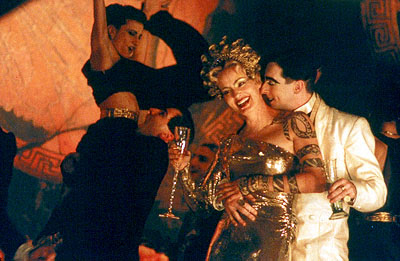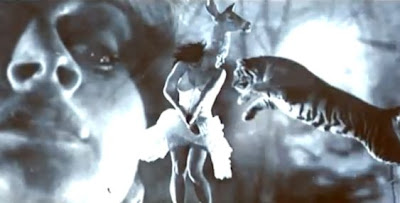Trigger warning: frank discussion of rape & PTSD
Julie Taymor’s Titus (based on Shakespeare’s Titus Andronicus) is a highly stylized production, involving elaborate costumes, body markings, choreography, era prop mash-ups, and extravagant violence. I tip my hat to Taymor for the scope and splendor of her vision, and I also applaud her for paving the way for other talented female directors in Hollywood. Though Taymor updates much of the Shakespeare play (using cars, guns, and pool tables alongside swords, Roman robes, and Shakespearean language), Taymor does little to re-interpret the female roles in an effort to make them more progressive and complex.
First, there’s Tamora, the barbaric queen of excess and unnatural sexual appetites.
 |
| Tamora: all-around orgy party gal |
 |
| This would be an awkward scene to walk in on. |
Tamora lacks an appropriate maternal instinct. She’s either too overbearing and clingy with her children, which reveals itself in her sexual attitude toward them, or she is a cold and immoral figure as is evinced by her desire to murder the infant son born from her affair with Aaron the Moor. (Even her relationship with Aaron, her black lover, is meant to be another example of her unnatural appetites, which is hella racist and could be the topic of a whole other post.) Lavinia pleads for Tamora to just kill her without letting her sons rape her, but Tamora is unmoved. This is another lost opportunity to show Tamora as having complex, compassionate, or even conflicted feelings at the sight of another woman begging for mercy in a mirror image of Tamora kneeling at Titus’ feet, weeping that he spare her son. Lavinia says to the sons, “The milk thou suck’dst from her did turn to marble,” and, at that point, the audience is inclined to agree, especially since Tamora is apparently so turned on by all this raping and murdering that she declares she’s going to find Aaron and have sex with him.
 |
| Lavinia: post-rape with her arms cut off then stuffed with branches and her tongue cut out |
Lavinia is raped, her arms hacked off then cruelly stuffed full of tree branches and her tongue cut out so that she can’t name her assailants. There is so much that a director could do to articulate the inhuman atrocity that’s been inflicted upon Lavinia. It is the epitome of victim silencing, literalizing the struggle many survivors face after their attack. Unfortunately, Taymor renders the rape of Lavinia in the same lavish, stylized manner as everything else. When Lavinia sees her attackers for the first time after her rape, Taymor uses an abstract hallucination sequence to symbolize the rape. Lavinia is wearing a deer head atop her own as two tigers leap towards her from either side.
 |
| W…T…F |
The sequence is bizarre, trippy, and kind of pretty, but it in no way expresses the horror of rape (not to mention the unimaginable horror of being dismembered). With all the stylizing and symbolizing Taymor’s doing, Lavinia’s rape is effectively trivialized.
When Titus first sees Lavinia after the attack, he says, “My grief was at the height before thou camest,
And now like Nilus, it disdaineth bounds.” Her father monologues about how her attack hurts him. Even Lavinia’s grief and her rape are not her own because Titus egotistically can only fathom his own pain, pride, and outrage. Throughout this scene and the rest of the film, Lavinia is a background adornment. As Titus bemoans his plight, Lavinia stands there without emoting or interrupting. The camera only shows her as meek and solemn. The only exception is a strange scene in which she is given a long stick in order to write the names of her attackers in the sand. Lavinia moves to put the tip of the stick in her mouth, and the audience recoils at the image that echoes fellatio (nobody wants to see a rape survivor performing simulated fellatio). Instead of putting the stick in her mouth, though, Lavinia frantically carves out the names as she is accompanied by discordant music. Instead of documenting her reaction to writing out the names (relieved? angry? exhausted?), the names themselves are focused on in an overhead shot, once again removing Lavinia’s agency and subjectivity.
Lavinia’s life and her death are both symbols. Her life is symbolic of her father’s honor, and after she’s raped, her lost chastity (puke) is symbolic of his shame. Her chastity, Titus insists, is more precious than her hands or tongue (projectile puke). In his mind, Titus must kill her in order to alleviate his own shame. Even Lavinia’s death at her father’s hands is meek and willing. The logic is that she’s so shamed, so “martyred” that death is preferable. It’s true that survivors may go through a host of emotions following their attack, and thoughts of suicide are not uncommon. Lavinia behaves as a doll, though, being positioned placidly for Titus to snap her neck. One could even defend her lack of emotions as PTSD (post-traumatic stress disorder), but I contest that Lavinia doesn’t have any real emotions because Taymor gave her very little depth of character, and Lavinia’s docile nature is more for convenience that to articulate the range of responses a survivor might have.
 |
| What’s the saying? “Like a lamb to the slaughter.” |
Tamora and Lavinia fit solidly into opposite camps of the virgin/whore dichotomy. Tamora = whore. Lavinia = virgin. The beauty of working from a play as source material is that a director has such incredible freedom to interpret character and setting appearance as well as character tone of voice, emotions, and actions. Though Taymor’s reboot is flashy and gritty, it doesn’t do much work to creatively re-imagine the inner life of its characters. In fact, it doesn’t appear to give much inner life to its female characters at all. In Taymor’s defense, the Shakespearean play does cast its women as virgin and whore, not allowing for much in the way of range. I just can’t accept a contemporary filmmaker (especially a woman) so cavalierly putting her only female characters in the same box as a 16th century white man, a box out of which women still struggle to climb today.

